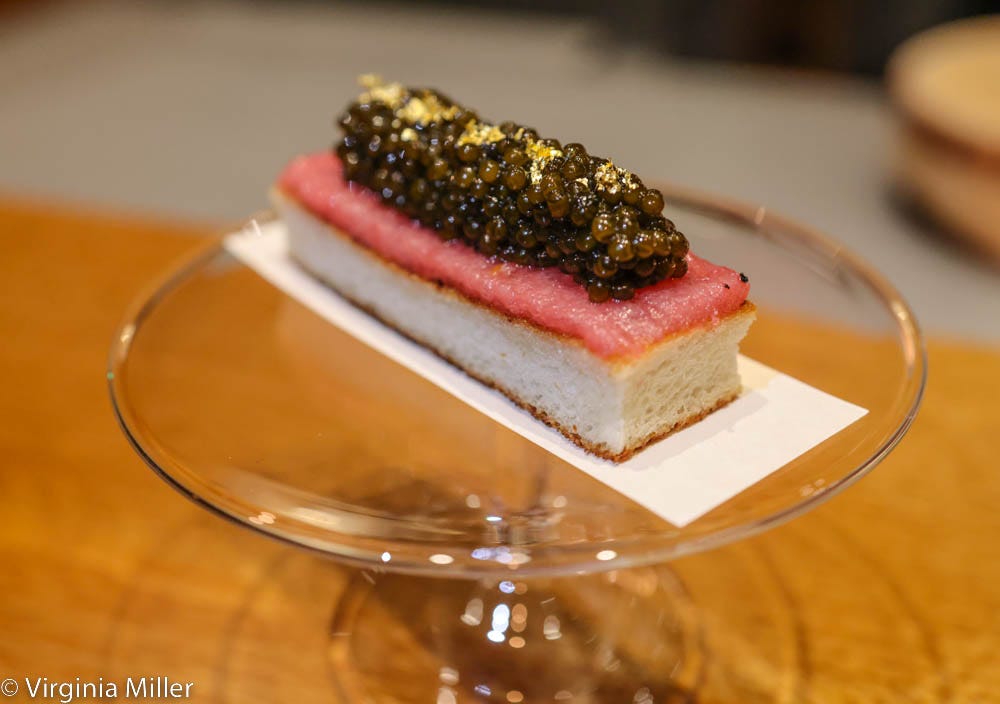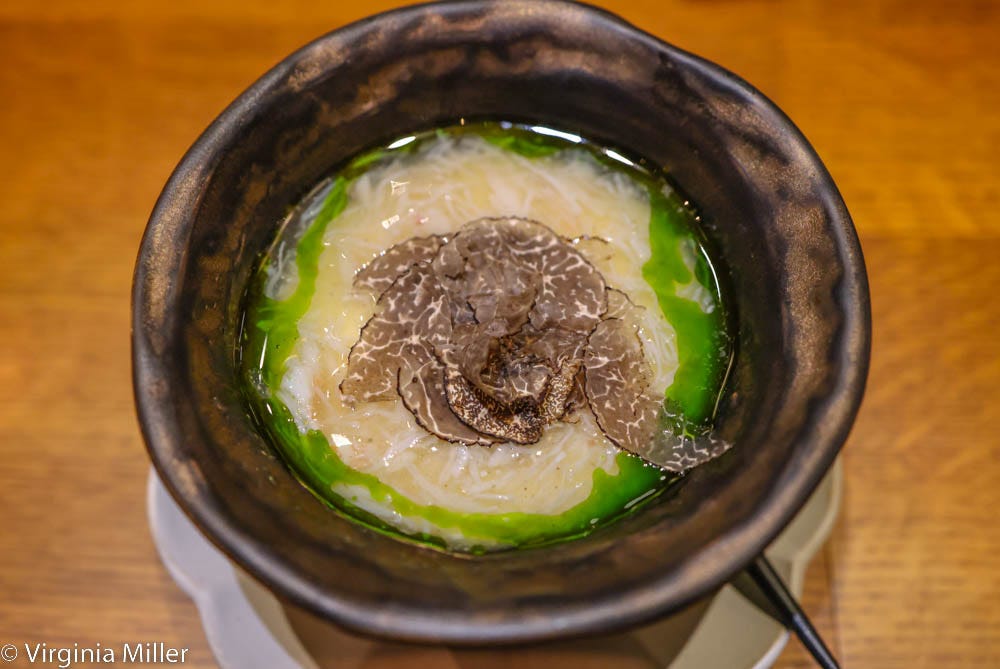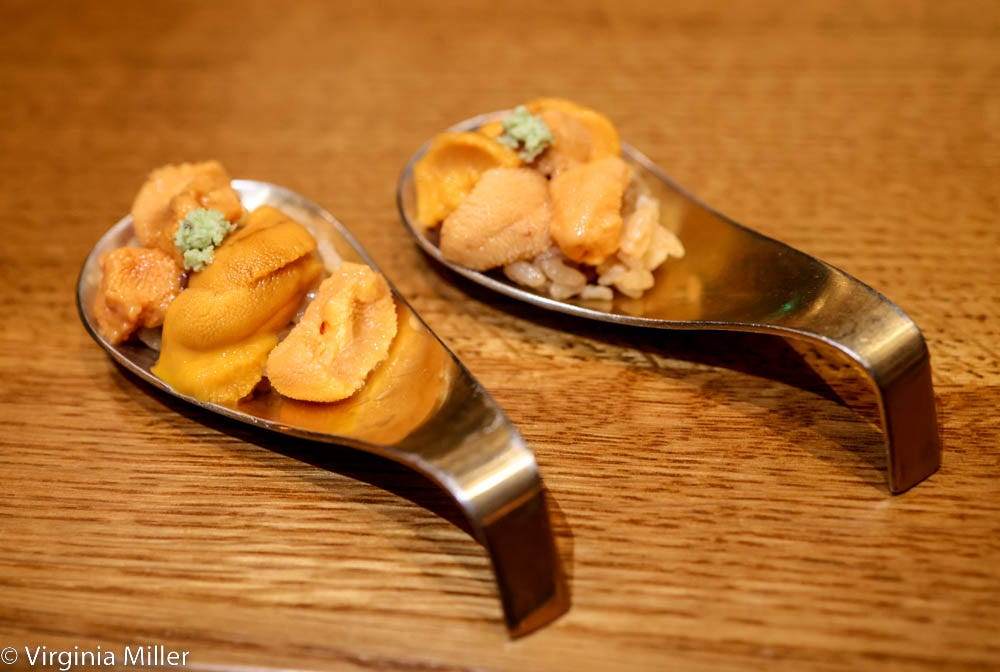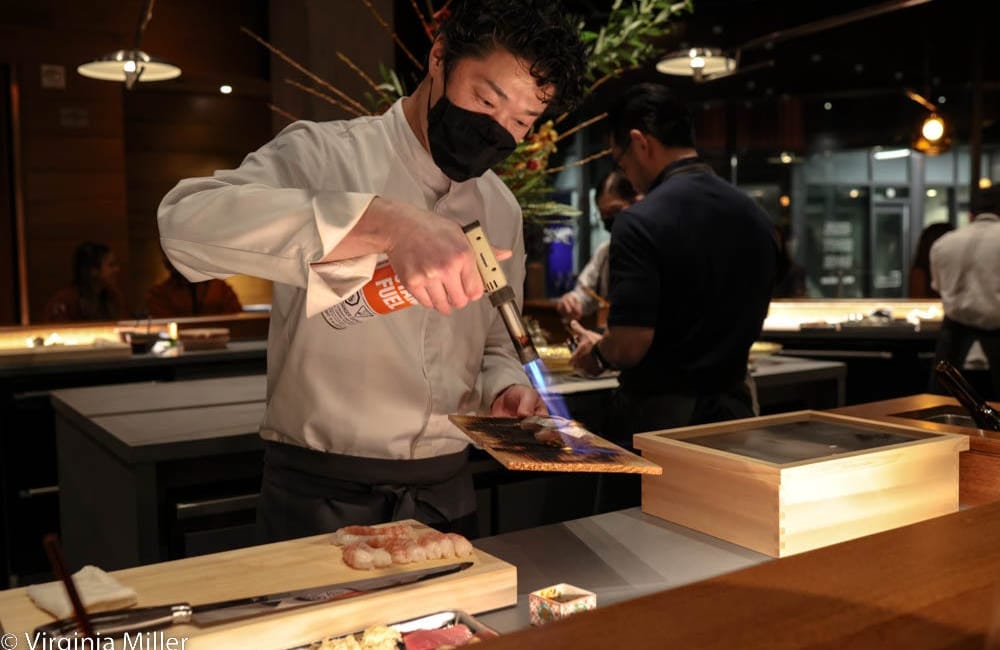
From The Shota to Omakase, San Francisco already has a wealth of Michelin-starred sushi bars, and many besides of that ilk (Oma SF Station, Ken, Sasa, Kusakabe, An Japanese, or hip counterparts like Robin and Chisai Sushi Club, to name just a few). Now we have another. But it’s a familiar name to San Franciscans: Akikos.
Opened in 1987, chef Ray Lee took over the tiny Bush Street sushi restaurant from his parents in 2009. It has been a cult favorite for decades and there will eventually be plans for the original space. But Akikos enters a whole new era as Lee just opened a 2,700 square-foot new Akikos off Avery Lane at the base of a luxury residential high-rise on January 10, 2023.
Designed by SF-based AvroKO, a warm, wood-lined entryway — holding shelves of records/vinyl, decanters, glassware, Japanese spirits and a counter with sake bottles on ice — leads into the gorgeous, wood-lined dining room centered by a massive, 24-seat sushi bar where you can watch the proceedings from all angles. Two glass-doored fridges flank a plating counter with fish hanging in dramatic view. Wood slats of the elevated ceiling above the sushi bar hold bold streaks of color from blue to red. The entire feel is warm, sleek, modern, as if we could be in Japan as much as San Francisco.

As profound lovers of Japan (from its culture and design to, of course, its food and drink), my husband Dan (“The Renaissance Man”) and I dined during soft opening week on a blustery, rainy January night. Rather than sitting with Lee, we sat with gracious head sushi chef Shinsuke Hayashi. The ensuing talk of Japan and his native Kyoto, which we adore, added personalized joy to the experience. We geeked out about sushi rice and vinegars, wasabi sources (theirs is Japan) and learned that a majority of their sushi team is from Japan.
We immediately saw the kaiseki influence (Kyoto being Japan’s key region for this style of artful tasting menu) in Akikos’ $250 omakase tasting menu. Seven courses of small plates roll into 10 pieces of nigiri for a full-on feast that transported us back to our beloved Japan. There is certainly fish from Japan’s famed Toyosu Fish Market (formerly Tsukiji) but also sourced fresh from local purveyors.
Diving initially into the otsumami (おつまみ, meaning finger foods, snacks or nibbles) yields much more than nibbles. These are key highlights and distinctions of Akikos’ menu compared to other sushi restaurants at this level. We began with a warm bowl of shirumono, or seafood soup typically laced with kelp, sardines, kombu and the like. Akikos’ version holds that nurturing of-the-sea broth brightened by saikyo miso, cradling fluffy fish dumplings. Sheer comfort.
We wove from a sashimi course (of hirame/olive flounder, akami/leaner center of tuna, kan buri/winter yellowtail) to a tender wagyu beef dumpling wrapped in a puff pastry, perched on round ceramics and dusted in aged parmesan. Yes, please.

Ubiquitous chawanmushi (egg custard) is here laced with snow crab and scallion oil, dusted in winter truffles. Cold-smoked Tyee Ora king salmon is silky and classic in trout roe but surprises with a touch of sweet onion jam. Hotate sunomono, or a cucumber salad with the ultimate Hokkaido scallops, arrives dramatically in a glass scallop shell, laced with lily bulbs in tosazu (a light dressing of vinegar, soy sauce, mirin and bonito dashi).
Maybe the most fun of a shining lineup of kaiseki-worthy bites is the shokupan (Japanese milk bread) course. Different than your typical milk bread, this is a rectangle of grilled milk toast layered in toro (fatty tuna), topped with golden kaluga caviar. It’s one decadent few bites, dissolving in the mouth.
On the drink side, we began with the only two cocktails on the menu, as they plan to have more eventually — they also have just a few select spirits, mostly Japanese, like the expected Roku Gin or a couple whiskies, plus Hine Cognac. Cocktails are a pricey $20–23, but served in striking “sneeze and they’ll break”, delicate Japanese stemware when it comes to the Cocomelon Manhattan (Suntory Toki Whisky, sweet vermouth, Bittercube Cherry Bark and Vanilla Bitters) or in a more robust but lovely rocks glass for the Ocean Forest (Roku Gin, kombu-infused vodka, dry vermouth). Both are nicely balanced, though I look forward to more creative house imbibements on future visits.

As you would expect, it’s more about sake, currently with over 30 selections and plans to grow. There are a few choice wine pours, including our great local Napa/Japan producer, Kenzo (more on this fascinating video game legend who splits his time between his Japan home and Napa, making elegant wines — and my past stay at his unforgettable Napa estate house). As sake devotees for a good 20 years now, including our studies of it in Japan, we delighted in pours like the creamy coconut, melon notes of Kamoizumi Nigori Ginjo Genshu (Summer Snow) in one of our favorite styles: unpasteurized. We also loved the sweet, nutty, subtly smokey notes of Tedorigawa Yamahai Daiginjo “Chrysanthemum Meadow.” We were thoughtfully attended to on the drink side by a gentleman who led us to the most interesting pours on their short-but-sweet menu. I look forward to seeing how the drink side evolves here.
Back to the food, our 10 nigiri sushi were delicate, dissolving mounds of goodness, as we talked red vinegars used in the spot-on rice with chef Hayashi, as well as wasabi sources as he grated fresh (and pricy) wasabi root from Japan, balancing its flavor profile with a touch of frozen wasabi. He’d place each finished nigiri on the wood bar in front us. We’d clean our fingers with the traditional hand sanitizing cloth next to our plate and eat up as chef wiped the counter clean, readying for our next nigiri. From kamasu (young barracuda) to ji kinmedai (goldneye red snapper), nama uni (Hokkiado sea urchin) to kawahagi (trigger fish), all was delectable and transporting to Tokyo sushi bars. A couple favorite bites were kegani (horsehair crab) and my always beloved anago (wild sea eel).

There is an additional add-on menu of nigiri options if you’re still hungry (we sure weren’t), including some of the bites already tried plus intriguing options like different kinds of uni: murasaki (long spine sea urchin) or nama (Hokkaido short spine uni). Lee has also been serving, besides ever-fab Santa Barbara urchin, a rare urchin from Kaigara Island in Russia.
In true Japanese fashion, dessert is pure and simple yet likewise perfected: goma white sesame ice cream, a lush, white scoop playfully served atop a ceramic white bowl that looks like a deflating balloon.
Along with a soundtrack that moves from hip hop to rock, the vibe here is chill even as it refined. Longtime Akikos’ fans may miss the cozy original, but this is an exciting — and I’d claim world-class — new era for the beloved SF family restaurant. One that, as it settles in, could easily become one of the nation’s great sushi bars with its own style and personality so beautifully San Francisco Japanese.
// 430 Folsom Street, http://akikosrestaurant.com







